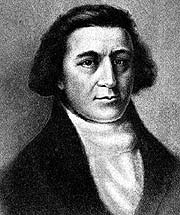Robert Gray
 |
| Capt. Robert Gray is credited with discovering and naming the Columbia River in 1792. Image © 2002 www.clipart.com. |
Thanks to Capt. Robert Gray, geographers could finally tell how wide the continent of North America was.
On May 11, 1792, Gray sailed his ship into an estuary along the Pacific and discovered the river he would name after his ship. Most importantly, using the mapping tools of the time, he was able to fix an exact latitude and longitude. With this information people like Thomas Jefferson were able to determine for the first time that North America was a continent some 3,000 miles wide. All that was left now was to explore that great unknown west of the Mississippi River. Thanks to Gray, Jefferson had a target.
Such a noted accomplishment was certainly not the main goal of Gray in 1792. No, first and foremost he was a Yankee trader.
Gray was born in Tiverton, RI, on May 10, 1755. In his early 20s he served in the Continental Navy during the Revolutionary War. After the war he continued his career at sea with a Massachusetts trading company.
In 1787 Capt. Gray and Capt. John Kendrick were commissioned by Boston merchants to sail up the Northwest coast of North America. The men carried a cargo of buttons, beads, blue cloth, and other trinkets to trade with the natives for pelts of sea otters. Sailing around South America, it took 10 months to reach the Oregon coast. The company then spent two seasons in the Pacific gathering furs. Sailing on to China, the captains traded the pelts for tea, silk, and spices to take back to Boston. This voyage made Gray the first American merchant sailor to circumnavigate the globe.
On April 2, 1792, Gray began his most famous voyage. Two vessels left Clayoquot Sound in present-day British Columbia, one going north for trade and Gray's ship, the Columbia, dropping southward. He may have been looking only for new sea otter trading fields, but his movements suggest that he was exploring for the legendary River of the West.
Gray had sailed for many miles through the narrow waters of the Strait of Juan de Fuca between present-day Washington and British Columbia. He was now heading south again to make a second attempt to sail behind the forbidding wall of Cape Disappointment in southern Washington. Gray crossed the cape's treacherous sandbar and sailed into the mouth of a great river. He named it for his ship, the "Columbia Rediviva." On May 11, 1792, the Columbia River was officially discovered and located.
After a few weeks of trading with the Indians, Gray left again without investigating where the Columbia led. Instead, he once again circumnavigated the globe. After his return to Boston in July 1793, he spent the remainder of his career as a merchant vessel commander along the Atlantic coast. He died in 1806 in Charleston and was buried at sea.
Gray's monumental discovery of the Columbia River gave the United States a strong claim to the Oregon Country. Other American fur traders were encouraged to use the Columbia River as a winter haven for their ships. By the end of the century, these traders controlled the sea otter trade, and the presence of the United States was firmly planted in the Pacific Northwest.
< back | next > | 


